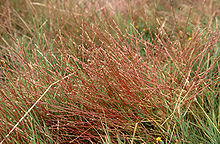Curved thin tail
| Curved thin tail | ||||||||||||
|---|---|---|---|---|---|---|---|---|---|---|---|---|

Curved thin tail ( Parapholis strigosa ) |
||||||||||||
| Systematics | ||||||||||||
|
||||||||||||
| Scientific name | ||||||||||||
| Parapholis strigosa | ||||||||||||
| ( Dumort. ) CEHubb. |
The curved thin tail ( Parapholis strigosa ) is an annual, deciduous grass belonging to the sweet grass family . Its fruits are mostly spread through the water.
Distribution, occurrence and protection
The curved thin tail occurs scattered on the North Sea coast , while it is only rare on the Baltic Sea coast . There is no grass in the interior. Otherwise the plant is widespread near the sea all over Europe and in Libya . In Australia and New Zealand as well as in North America it is a neophyte.
It is endangered in Central Europe and is on the red list of vascular plants in Germany, where it is listed in risk class 3. It is endangered in Schleswig-Holstein , Hamburg , Bremen and Lower Saxony , and even threatened with extinction in Mecklenburg-Western Pomerania . Its populations are primarily endangered by the failure to flood salt marshes and marshes and their increasing development by humans. Coastal protection measures are also decimating its populations.
The grass has its main occurrence in the salt plant corridors formation. It is the association characteristic of the beach fattening societies (Saginion maritimae), but also occurs in the Juncetum gerardi.
The curved thin tail grows on alternately moist, mostly gappy coastal salt meadows and occurs there in gaps between the zone of Andelrasen and red fescue lawn. It prefers alternately moist, partly flooded, salty, clayey-sandy soils and indicates a moderate salinity, maritime climate and flooding.
Identifying features
The annual curved thin tail is an inconspicuous, tufted, branched grass that is only 5 to 20 cm in size and blooms in June and July. Its stalks are two to five knotted and branched at the lower nodes. They grow upright or kinky (kneeling) ascending. The grass is thin and hairless. Its often protruding leaves are gray-green in color or are still fresh green when young. The leaves are extremely short and narrow and appear folded together. They are no longer than 5 cm and no wider than 2.5 mm. Like the stalk, they are very strongly curved. The leaf sheaths are smooth and glabrous. The ligule is an approximately 0.5 mm long, membranous border.
The tiny, sessile spikelets are single-flowered or rarely two-flowered and provided with an extension of the spikelet axis above the florets. They form a terminal, about 3 to 10 cm long and max. 1.5 mm wide ear from that breaks very quickly when ripe, so often a broken blade of grass can be seen. The spikelets are alternately sunk into the rachis, are about 4 to 6 mm long, form two identical, three- to five-nerved, pointed, broad-lanceolate, keeled glumes and are pressed tightly with their flat side against the rachis. The tender-skinned lemmas are weakly three-nerved, 1 mm shorter than the glumes, broadly lanceolate and hairless. The soft-skinned, glabrous, two-nerved palea is as long as the lemma. 2 to 3 mm long anthers are formed. The ovary has a bare, membranous border at the top. The caryopsis fruits are no longer than 3 mm and have a short, membranous appendage at the top.
The number of chromosomes is 2n = 14 or 28.
Taxonomy
Parapholis strigosa (Dumort.) CEHubb. has the synonyms: Lepiurus strigosus Dumort. , Lepturus incurvatus var. Vulgatus Asch. & Graebn. and Lepturus incurvatus subsp. vulgatus (Asch. & Graebn.) Rouy .
swell
- Royal Botanic Gardens, Kew, World Grass Species Database
- Eckehart J. Jäger, Klaus Werner (Ed.): Excursion flora from Germany . Founded by Werner Rothmaler. 10th edited edition. tape 4 : Vascular Plants: Critical Volume . Elsevier, Spektrum Akademischer Verlag, Munich / Heidelberg 2005, ISBN 3-8274-1496-2 .
- Jürke Grau , Bruno P. Kremer, Bodo M. Möseler, Gerhard Rambold, Dagmar Triebel: Grasses. Sweet grasses, sour grasses, rushes and grass-like families in Europe (= Steinbach's natural guide ). New, edit. Special edition edition. Mosaik, Munich 1996, ISBN 3-576-10702-9 .
- Hans Joachim Conert: Parey's grass book. Recognize and determine the grasses of Germany . Parey, Berlin 2000, ISBN 3-8263-3327-6 .
Individual evidence
- ↑ a b Rafaël Govaerts (ed.): Parapholis strigosa. In: World Checklist of Selected Plant Families (WCSP) - The Board of Trustees of the Royal Botanic Gardens, Kew . Retrieved November 11, 2016.
- ↑ a b Erich Oberdorfer : Plant-sociological excursion flora for Germany and neighboring areas . 8th edition. Verlag Eugen Ulmer, Stuttgart 2001, ISBN 3-8001-3131-5 . Page 240.
Web links
- Curved thin tail. In: FloraWeb.de.
- Curved thin tail . In: BiolFlor, the database of biological-ecological characteristics of the flora of Germany.
- Distribution in the northern hemisphere according to: Eric Hultén , Magnus Fries: Atlas of North European vascular plants 1986, ISBN 3-87429-263-0
- Thomas Meyer: Data sheet with identification key and photos at Flora-de: Flora von Deutschland (old name of the website: Flowers in Swabia )

